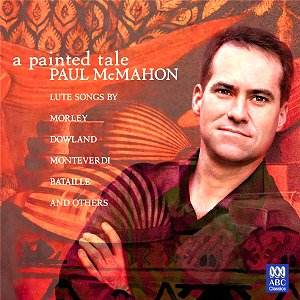Paul McMahon’s biography is at the back of the CD booklet.
There he is described as ‘one of Australia’s leading tenors’
who has appeared in many operatic roles: e.g. ‘Die Zauberflöte’
and ‘Carmen’. He has an impressive itinerary but at no point
does early music, especially of this period, seem to feature.
Still, we all start somewhere and anyway he may well have known
this music for some years. It is a significant point however
and one should also bear in mind that the opportunities for
early music performances in Australia are not as great as in
Britain. Therefore his commitment to recording this music must
be based on a strong personal desire and love of the repertoire.
In most cases it is quite clear that this is so.
So here we have French, Italian and English music of
a period from c.1570-1640. This covers a very important period
when much was going on. A singer needs versatility and sensitivity
to cover the three countries successfully. I suspect that no
other recording of similar repertoire is available on one CD.
The English Lute songs come off less well, I feel. Indeed
the disc starts with a very dull and unpromising version of
‘It was a lover’. Having heard it I did not particularly relish
listening to the remaining seventy minutes. More often than
not McMahon does not characterize the English songs as much
as he should. Perhaps he feels that their more folk-like simplicity
means that they more or less sing themselves. ‘Come again, sweet
Love’ may appear to be a straightforward sing BUT I would advise
any singer to contemplate the words very carefully. McMahon
and Tommie Anderson would have done well to have heard Paul
Agnew in Dowland (Metronome 1011). Agnew sings with subtlety
and yet passion. He acts out the words with careful placing
of consonants and makes you live the poem with him.
McMahon’s recital ends with what is perhaps Dowland’s
greatest song ‘In darkness let me dwell’. This is artistically
a brave move and of course he would not end a live recital with
this deeply melancholy piece. Nevertheless it does work ...
in a way. It’s difficult in fact, as one looks through the disc,
to decide quite what would have been a good song to end with;
perhaps Morley’s ‘Who is it’ with its unusually soloistic lute
part, might have worked. However again perhaps McMahon should
hear the beautifully paced performance on RCA by Peter Pears
and Julian Bream. This was recorded in the late 1960s and demonstrates
what can be done with this song. It’s all irrelevant anyway
because, as a listener, you can programme whatever you fancy.
If however you did decide to listen to the complete recital
from beginning to end there would never be a problem of lack
of variety in so far as the music of three countries is mixed
considerably as you go through.
The French and Italian songs, in contrast to what I have
said so far, come off very well. McMahon’s French is excellent.
He has very expressive French vowels and his use of clear, subtle
yet firm ornamentation is just right. These songs are mostly
strophic so ornamenting the later verses is necessary. I especially
noticed this in ‘Enfin le beauté’ by Mouline, the longest song
on the CD.
The Italian pieces are even better. There is a real understanding
of the idiom especially in the ‘Nigra Sum,’ from Monteverdi’s
‘Vespers’. Here we have passion and joy characterized side by
side. McMahon carries this off smoothly yet movingly.
In all of this he is aided by some sensitive lute playing
by Tommie Anderson. The bass lines of many of the songs is strengthened
with a viol da gamba played by the sensitive and supportive
Daniel Yeadon. Warranting special mention in this regard is
the little known but beautifully sober song by Ferrabosco Junior
‘ So beauty on the water’ where the viol adds a perfect plangent
bass to complement the lovely legato melody. Morley’s ‘Who is
it’ works well also, with its separate and elegant bass line
adding a counterpoint to the lute.
All in all, a worthy and enjoyable disc of not always
run-of–the–mill repertoire, nicely and naturally recorded.
Gary
Higginson

![]() Paul McMahon; tenor with Tommie Anderson lute; Daniel Yeadon, viola da
gamba
Paul McMahon; tenor with Tommie Anderson lute; Daniel Yeadon, viola da
gamba![]() ABC CLASSICS 476 192-9 [72.08]
ABC CLASSICS 476 192-9 [72.08]





